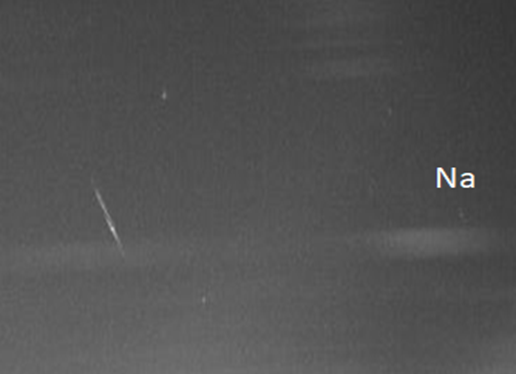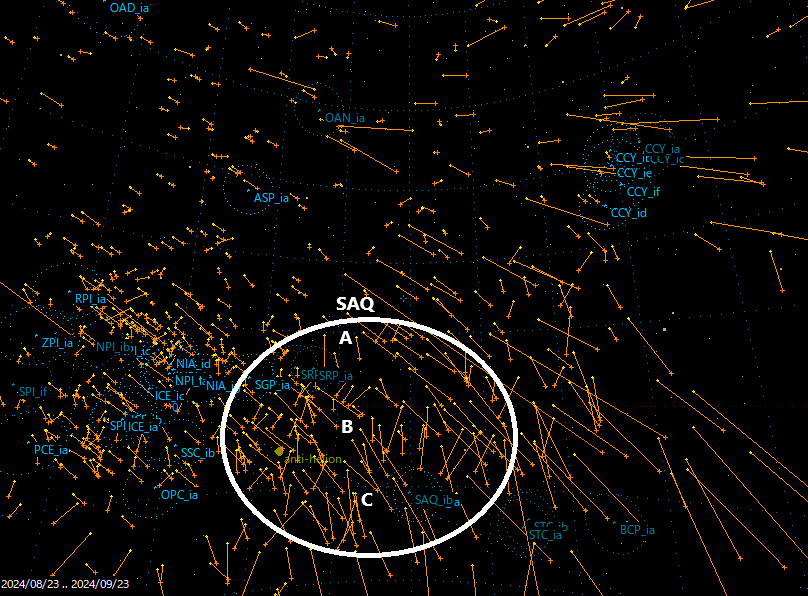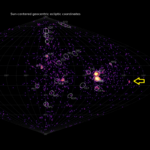Abstract: Asteroid 2024 RW1 (CAQTDL2) entered the atmosphere as predicted, and a large fireball was seen from the Philippines. This is the ninth asteroid discovered before entry in the Earth’s atmosphere, following 2024 BX1 in January this year. After investigating whether there were any meteors associated with this, about 15 meteors with similar orbits were found by Japan’s SonotaCo network. Two of them were also photographed with a spectrum. The spectral type is Na rich. It was also found that asteroid 2024 RW1 has an orbit that is very similar to the SAQ#475 meteor shower in September, and it appears that there are three groups.
Observations
About 15 meteors possibly associated with asteroid 2024 RW1 (CAQTDL2) were simultaneously observed by Japan’s SonotaCo Network between September1and September 7. Two of them were also photographed with a spectrum (Figures 1 and 2). The activity appeared from September 1st to around the 14th, with slightly more events on September 5–6 and 6–7. Single-station observations on Mauna Kea also revealed that a total of about 30 meteors of the same group were observed on September 4–5 and 5–6.

Figure 1 – The spectrum of 2024 September 5, 12h17m17s UTC.

Figure 2 – The spectrum of 2024 September 2, 15h42m44s UTC.
Results
According to Hasegawa, radiants were determined on September 3rd to 5th from single station meteor trails from a live video of Mauna Kea. The radiant points are dispersed, but concentrated enough (Figure 3). To find the radiant point from a single meteor, first extract meteors that pass within a certain range (radius of 5 degrees) of the expected radiant point, then find the poles of the great circles of the meteor trails (two points). If they are from the same group, the great circle made by the poles of the paths will be on a great circle with the radiant point as its pole, so the pole of that great circle determined using the least squares method becomes the coordinates of the radiant point.



Figure 3 – Radiant map from Mauna Kea Live.
The distribution of the radiants from simultaneous observations by SonotaCo Net is shown in Figure 4. As with the single station data, there is a spread, but they can be divided into three groups (Figure 4).

Figure 4 – Radiant map from SonotaCo Net. The yellow points are the apparent radiant points (Ro) and the orange + is the true radiant point (Rt).

Figure 5 – Plot of the orbits from SonotaCo Net.
The plot of the orbits also shows a spread, but it is divided into two groups (Figure 5).
Furthermore, by calculating the average orbit from the orbital elements, it was found to be divided into three groups (Table 1).
Groups A and B are north-south groups. Group C has a difference of 180 degrees in ω and Ω. The map of simultaneous meteor tracks from August 23 to September 23 shows three groups that appear to be related to the SAQ meteor shower (Figure 6). Furthermore, what seems to be the part of the same group appears to have a dispersion into three groups.

Figure 6 – Radiant map from August 23rd to September 23rd.
Table 1 – The orbital elements, geocentric radiant and velocity, and other orbital parameters.
| Group | λʘ (°) |
αg (°) |
δg (°) |
vg (km/s) |
a (AU) |
q (AU) |
e | ω (°) |
Ω (°) |
i (°) |
MA | dur (sec) |
HB (km) |
HE (km) |
DSH | λΠ | βΠ |
| A | 159.35 | 330.71 | -9.80 | 17.09 | 2.19 | 0.727 | 0.668 | 252.41 | 159.33 | 1.07 | -3.2 | 0.9 | 80.3 | 68.3 | 0.05 | 51.7 | -1.02 |
| 159.46 | 334.43 | -10.46 | 20.57 | 2.96 | 0.662 | 0.777 | 257.67 | 159.16 | 0.08 | -0.1 | 1.3 | 89.6 | 79.6 | 0.12 | 56.8 | -0.08 | |
| 160.34 | 320.19 | -7.27 | 14.23 | 2.29 | 0.830 | 0.638 | 236.99 | 160.33 | 3.23 | -0.4 | 2.1 | 84.2 | 61.4 | 0.21 | 37.3 | -2.71 | |
| 162.24 | 335.46 | -8.09 | 17.81 | 2.17 | 0.700 | 0.677 | 255.94 | 162.22 | 1.10 | -3.5 | 1.4 | 73.0 | 52.7 | 0.09 | 58.2 | -1.07 | |
| 163.26 | 321.82 | -5.78 | 13.92 | 2.27 | 0.838 | 0.631 | 235.72 | 163.25 | 3.51 | -0.3 | 2.0 | 82.8 | 61.6 | 0.20 | 38.9 | -2.9 | |
| B | 160.32 | 329.31 | 5.04 | 19.49 | 2.50 | 0.696 | 0.721 | 255.00 | 160.32 | 9.82 | 1.0 | 1.1 | 96.4 | 76.6 | 0.17 | 55.1 | -9.48 |
| 160.40 | 328.39 | 6.69 | 20.00 | 2.72 | 0.699 | 0.743 | 253.75 | 160.39 | 11.11 | -0.2 | 1.8 | 89.1 | 64.9 | 0.19 | 53.9 | -10.7 | |
| 162.15 | 315.09 | 1.23 | 13.26 | 2.25 | 0.868 | 0.615 | 230.68 | 162.15 | 6.54 | 0.4 | 0.5 | 80.4 | 72.4 | 0.29 | 32.7 | -5.06 | |
| 163.00 | 338.46 | 0.10 | 22.51 | 3.01 | 0.606 | 0.799 | 264.17 | 163.00 | 6.18 | 0.1 | 1.6 | 99.9 | 83.2 | 0.27 | 67.1 | -6.15 | |
| 163.09 | 322.48 | 4.63 | 14.18 | 1.99 | 0.820 | 0.588 | 240.29 | 163.09 | 7.62 | -0.8 | 0.6 | 77.0 | 68.2 | 0.22 | 43.2 | -6.61 | |
| 163.11 | 311.94 | 2.52 | 13.35 | 2.53 | 0.886 | 0.650 | 226.12 | 163.10 | 7.21 | 0.5 | 0.9 | 89.4 | 75.4 | 0.33 | 29.0 | -5.19 | |
| C | 160.18 | 342.59 | -10.01 | 20.95 | 2.07 | 0.584 | 0.718 | 90.51 | 340.19 | 1.72 | -0.4 | 0.2 | 85.6 | 83.1 | 0.28 | 70.7 | 1.72 |
| 161.20 | 328.45 | -20.66 | 15.05 | 2.34 | 0.807 | 0.654 | 60.30 | 341.21 | 3.26 | -0.5 | 1.0 | 81.5 | 69.3 | 0.17 | 41.5 | 2.84 | |
| 162.24 | 333.03 | -19.44 | 18.06 | 3.11 | 0.756 | 0.757 | 65.30 | 342.25 | 4.12 | -0.1 | 1.0 | 90.3 | 77.9 | 0.11 | 47.5 | 3.74 | |
| 164.19 | 344.09 | -22.74 | 21.89 | 4.01 | 0.675 | 0.832 | 74.15 | 344.19 | 9.75 | 1.0 | 0.6 | 86.1 | 78.4 | 0.23 | 58.1 | 9.38 | |
| A | 160.93 | 328.52 | -8.28 | 16.72 | 2.38 | 0.751 | 0.678 | 247.75 | 160.86 | 1.80 | -1.5 | 1.5 | 82.0 | 64.7 | |||
| B | 162.01 | 324.28 | 3.37 | 17.13 | 2.50 | 0.763 | 0.686 | 245.00 | 162.01 | 8.08 | 0.2 | 1.1 | 88.7 | 73.5 | |||
| C | 161.95 | 337.04 | -18.21 | 18.99 | 2.88 | 0.706 | 0.740 | 72.56 | 341.96 | 4.71 | 0.0 | 0.7 | 85.9 | 77.2 |
In addition, it was found that both of the two meteors in the spectrum were richer in Na than Mg. Figure 2 has a poor dispersion direction, but we managed to analyze it
(Figure 7). The type is normal, but Na is more abundant than Mg, and a lot of iron seems to have been released during the explosion.

Figure 7 – Spectral analysis results. No sensitivity correction was applied. Spectral type is Normal.
Parent body
As shown in Table 2, there is a candidate parent body for the three groups. Groups A and B are related to asteroid 2024 RW1. Group C is related to asteroid 2022BM2. It is thought that these two asteroids once split off from the same asteroid.
The asteroid is considered to be a parent body of this group because it has been determined to be related to the SAQ#475, or September Aquariids meteor shower. However, this meteor shower has been removed from the active working list of the IAU MDC because of its low reliability. The radiant points are widely dispersed, but the slow speed for the activity of the three groups, and because of the similarities in their orbits it is thought that this asteroid is the parent body of these associated meteor showers (Figure 8). From January 2nd to September 10th of last year, there were nearly 20 simultaneous meteors with DSH values of 0.2 or less. As expected, they are split into two groups, and the radiant points are dispersed.

Figure 8 – Plot of the orbit of 2024RW1.
Table 2 – Orbit data and orbital elements of the parent body candidate.
| Name | a
(AU) |
e | q
(AU) |
i (°) |
ω (°) |
Ω (°) |
DSH | TJ | λΠ | βΠ | αg (°) |
δg (°) |
vg (km/s) |
| 2024 RW1 | 2.51 | 0.707 | 0.735 | 0.53 | 249.62 | 162.46 | 0.00 | 3.06 | 52.08 | -0.50 | 332.5 | -10.3 | 17.5 |
| A | 2.51 | 0.678 | 0.738 | 1.80 | 247.75 | 160.86 | 0.06 | 3.21 | 48.60 | -1.67 | 328.5 | -8.3 | 16.7 |
| B | 2.30 | 0.686 | 0.723 | 8.08 | 245.00 | 162.01 | 0.15 | 3.12 | 46.79 | -7.32 | 324.3 | 3.4 | 17.1 |
| C | 2.51 | 0.710 | 0.720 | 3.03 | 72.03 | 341.22 | 0.11 | 2.88 | 54.46 | 4.49 | 337.0 | -18.2 | 19.0 |
| 2022BM2 | 2.51 | 0.706 | 0.738 | 0.88 | 71.74 | 346.14 | 0.03 | 3.05 | 57.88 | 0.84 | 336.7 | -11.4 | 18.4 |
Acknowledgment
We would like to thank the SonotaCo network for providing orbital calculation data for this study. We would also like to thank Paul Roggemans for proofreading and advice.




